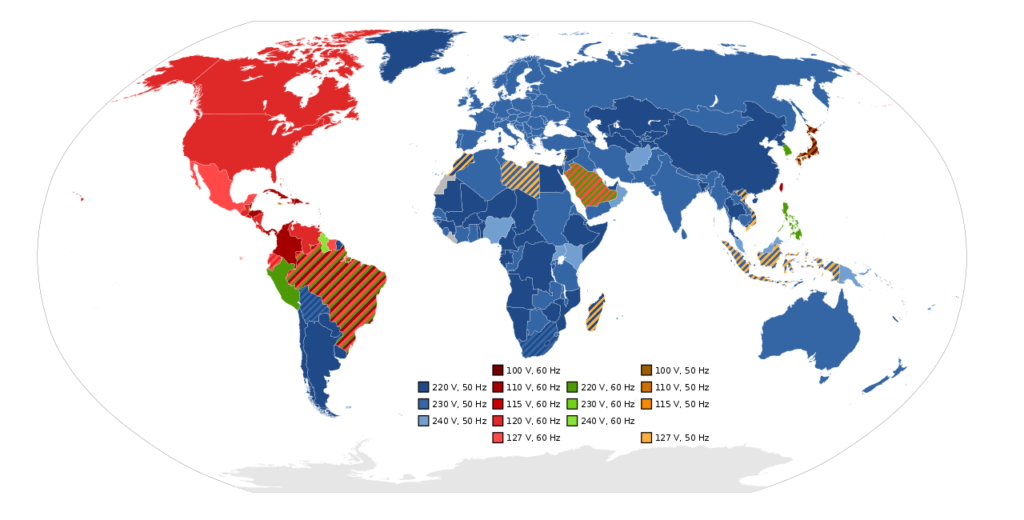A voltage converter is a device that can be used to convert electricity from 220 volts to 110 volts or 110 volts to 220 volts.
Step Down Voltage Converter:
Step Down voltage converters are used to step down electricity in countries that use 220 volts, 230 volts, or 240 volts. These voltage converters will step the electricity down to 110 volts so you can use electronics and appliances from North America that are 110 volts in countries that have 220, 230 or 240 volts electricity such as Europe, Asia, Middle East, and Africa. These converters are perfect for international travel as well as international relocation.
They are also very commonly used by companies that are selling products that are 110 volts into the 220 volts markets. Step down voltage converters are available in many sizes and types. The sizes are measured by the max load they can handle. More info on this is below. Many models below are two-way voltage converters which means they will step up and step down voltage.
Step Up Voltage Converter:
Step up voltage converters are exactly the opposite of step down voltage converters. All the step up voltage converters we carry also work for step down. The can be used both ways, to step up voltage from 110 volts to 220 volts, and also to step down voltage from 220 volts to 110 volts. Step up voltage converters are great for people that have relocated to the USA or are traveling to the USA from Europe, Asia, Middle East or Africa. Step up voltage converter models are sold in many different sizes as well. We also offer a few different types. Please see the instructions below on how to select the correct converter as well as a comparison chart of the various step up voltage converters we carry. Please note that the two-way converters below will step up voltage and also step down voltage meaning they can be used as a step up voltage converter as well as a step down voltage converter.
Newest Diamond Series voltage converter for international relocation, deployment, or travel now available. Newest design and best voltage converter with Diamond Series has 5 Year Limited warranty and is CE approved.
We carry three types of voltage converters / transformers and two types of voltage converters with a built in regulator. Reading through the brief descriptions will help you choose which one you need. All voltage converters and transformers are available in different Watts. We carry both step up and step down models. Perfect for international relocation and international travel to use foreign electronics in the USA or USE 110 volt electronics from USA overseas. Please contact us at 877-578-0587 for any questions regarding which transformer is suitable to use in a given country or with a given product.
We carry everything you will need for an international move, relocation, or deployment. We have Multi system Pal/NTSC TVs, VCRs, DVD players, GSM Phones, and much much more.
Please remember that the terms "voltage converter", "voltage transformer", and "power transformer" all mean the same thing.
Voltage Converters - Voltage Transformers 110 volts, 220 volts, 230 volts 240 volts for use anywhere in the world. Over 100,000 units sold. Used all over the world for international travel, international relocation, yachts, military deployment, and many other applications. We have the must durable, reliable voltage converters available, and have been in business since 1979.
How To Find the Watts On Your Appliance So That You Can Select the Correct Transformer
Voltage converters, also known as voltage transformers, are devices that convert foreign electricity to power devices from different parts of the world. A step down voltage converter is a 220 to 110 volts converter. A step up converter is a 110 volts to 220 volts converter. Our 2-way converters are voltage transformers that convert power from both 220 to 110 volts and 110 to 220 volts. They also work with 100 volts, 110 volts, 120 volts, 220 volts and 240 volts. This model is a 2 way voltage converter / voltage transformer available in many different sizes including 100 Watts, 200 Watts, 300 Watts, 500 Watts, 750 Watts, 1000 Watts, 1500 Watts, 2000 Watts, 3000 Watts and 5000 Watts.
To determine the correct model voltage converter or heavy duty transformer you need, you must find the Watts of your appliance. You can find this information listed on the appliance manufacturer's label located on the back or bottom of the appliance or in the specifications section of the appliance owner's manual. We recommend using a voltage converter / transformer which has a max Wattage of at least 50% higher than your appliance. Some appliances such as power tools, motors, laser printers and TVs require a converter 2-3 times the Watts that the appliance is rated for.
-A higher Watt rated transformer will never hurt your appliance, however if you buy one that is not strong enough, it will not work.
-Items such as TVs, Microwave ovens, laser printers and power tools require a transformer with 3 times the Wattage rating on the equipment. This is because these items require a surge of power when they are first turned on.
IMPORTANT NOTE: Watts may be abbreviated as W on your appliance. However if you can't find Watts or W on the label of your appliance, then you may be able to find Amps, also known as amperage or A. This can be converted to Watts in order to select the correct converter.
If only the amperage rating is shown, multiply the input voltage by the amperage rating to find the wattage rating. Volts x Amps = Watts, e.g. 110V x 1.5 A = 165W
Cycles - 50 Hz vs. 60 Hz
North American 110-120 volt electricity is generated at 60 Hz (cycles) alternating current. Most foreign 220-240 volt electricity is generated at 50 Hz (cycles) alternating current. This cycle difference will cause analog clocks and timing circuits that use alternating current as a timing base to keep incorrect time. Most modern electronic equipment including battery chargers, computers, printers, stereos, tape and CD players, VCR/DVD players, CRT, Plasma, or LCD TVs and Monitors, etc. will not be affected by the difference in cycles.
Frequently Asked Questions About Voltage Converters
Step-Down Only or Step-Up/Step-Down Voltage Converters
In North America, parts of South America and a few other places, a 110 volt standard is used. In the majority of the world, 220 volts is the standard. When appliances from 110 volt countries need to be used in 220 volt countries, a “Step-Down” voltage converter is needed. When appliances from 220 volt countries need to be used in 110 volt countries, a “Step-Up” voltage converter is needed.
110 Volts vs. 120 Volts or 220 Volts vs. 230 Volts vs. 240 Volts?
Voltage converter ratings are generally within a voltage range. Appliances rated for 110 volts or 120 volts can usually operate from anywhere between 100 volts and 127 volts. Likewise, 220 volt or 230 volt appliances can usually operate from anywhere between 220 volts and 240 volts. Therefore, any quality Step-Down voltage converter will allow any 110 volt appliance to operate in 220 volt, 230 volt or even 240 volt countries. This is also true with a quality Step-Up voltage converter, which will allow any 220 volt appliance to be used in any 110 volt or 120 volt countries.
What About Voltage Stabilizers?
In some countries, the voltage fluctuates a lot more than a few volts. In many areas, “brownouts” are very common. This occurs when the voltage dips so low that lights actually dim considerably. For most appliances, this is a lot worse than if the voltage just completely shut off. Often, this low voltage condition is followed by a surge of power, which can also damage electrical appliances.
To protect your valuable electronics, we offer high quality voltage converters with voltage stabilizers built right in. Our Type 4 and Type 5 voltage transformers keep the output voltage stable no matter how much the input voltage varies. If the condition becomes too extreme, these high quality voltage converters will simply shut down, protecting your appliances.
What about the Hertz? 50hz vs. 60hz?
In general, the difference in Hertz never hurts anything! In North America, and a few other places, 60hz is the standard. However, in most of the world 50hz is the standard. These numbers represent the “frequency” of the A/C voltage. Voltage converters only convert the voltage, not the frequency.
Normally, this is not an issue, as most modern appliances are rated 50/60hz. Most high tech appliances have internal systems which regulate the frequency they are using. When purchasing a voltage transformer, the frequency (50hz or 60hz) generally does not matter.
Washers and dryers are exceptions to this. A 50 hertz washer or dryer cannot be used on a 60 hertz circuit. Likewise, a 60 hertz machine cannot be used on a 50 hertz circuit. Analog clocks also rely on the frequency to operate correctly, so they cannot be used on different frequencies than what they are rated for.
If you have highly sensitive electronic equipment, check with the manufacturer before using any voltage transformer.
 Voltages around the world.[/caption]
As a result of this distinction, some electronics will work without issue in certain countries while not functioning properly in others. Specifically, when appliances from 110 volt countries need to be used in 220 volt countries, a "Step-Up" voltage converter is needed. When appliances from 220 volt countries need to be used in 110 volt countries, a "Step-Down" converter is required.
[caption id="attachment_1610" align="aligncenter" width="231"]
Voltages around the world.[/caption]
As a result of this distinction, some electronics will work without issue in certain countries while not functioning properly in others. Specifically, when appliances from 110 volt countries need to be used in 220 volt countries, a "Step-Up" voltage converter is needed. When appliances from 220 volt countries need to be used in 110 volt countries, a "Step-Down" converter is required.
[caption id="attachment_1610" align="aligncenter" width="231"] Step-Up vs Step-Down, visualized.[/caption]
Step-Up vs Step-Down, visualized.[/caption]

 If you're traveling to India, whether for vacation or business, there's quite a bit you're going to need to know before embarking on your trip. From cultural differences and currency exchange rates to saying hello and thank you in the native language, it's best to know what to expect and to be prepared prior to your arrival.
Surprisingly, one of the most overlooked factors of international travel - regardless of the destination - is bringing your electronics along with you. Now, when we speak of traveling with electronics we're not talking about how to keep them safe or how to properly pack them into a suitcase or travel bag. We're talking about being able to actually USE them once you arrive at your destination. It all comes down to one basic and underrated necessity - electricity.
See, in different areas of the world there are different standard voltages for electricity. The voltage delivered from a utility company to the outlet/socket varies from region to region and even from country to country. In North America, the standard voltage is 110 volts (also known as 120), while the European standard is 220 volts (also known as 240). The reason this variation causes such an issue for travelers is because nearly all electronic devices are manufactured to operate ONLY at the native voltage of the area from which they were sold. In other words, depending on where you travel to, your electronics will not always work. Firstly, the difference in voltage will lead to one of two results. Either
1. Your electrical devices will not work because they're not recieving enough voltage to power them, or
2. Your devices will be damaged or destroyed because they were fed nearly double the voltage they are supposed to have.
Of course this all depends on where you're coming from. If you are from a 220 volt standard country (France), and travel to a 110 volt country (North or South America), your equipment will only recieve about half the voltage that it was intended for. Typically this won't cause any harm but it's not enough volts to power or even charge your item. On the other hand, if you're from a 110 volt country traveling to a 220 volt country and attempt to plug in your electronics, they will most likely be damaged or completely ruined. You also run the risk of starting a fire and/or being electrocuted. Not fun!
[caption id="" align="left" width="294"]
If you're traveling to India, whether for vacation or business, there's quite a bit you're going to need to know before embarking on your trip. From cultural differences and currency exchange rates to saying hello and thank you in the native language, it's best to know what to expect and to be prepared prior to your arrival.
Surprisingly, one of the most overlooked factors of international travel - regardless of the destination - is bringing your electronics along with you. Now, when we speak of traveling with electronics we're not talking about how to keep them safe or how to properly pack them into a suitcase or travel bag. We're talking about being able to actually USE them once you arrive at your destination. It all comes down to one basic and underrated necessity - electricity.
See, in different areas of the world there are different standard voltages for electricity. The voltage delivered from a utility company to the outlet/socket varies from region to region and even from country to country. In North America, the standard voltage is 110 volts (also known as 120), while the European standard is 220 volts (also known as 240). The reason this variation causes such an issue for travelers is because nearly all electronic devices are manufactured to operate ONLY at the native voltage of the area from which they were sold. In other words, depending on where you travel to, your electronics will not always work. Firstly, the difference in voltage will lead to one of two results. Either
1. Your electrical devices will not work because they're not recieving enough voltage to power them, or
2. Your devices will be damaged or destroyed because they were fed nearly double the voltage they are supposed to have.
Of course this all depends on where you're coming from. If you are from a 220 volt standard country (France), and travel to a 110 volt country (North or South America), your equipment will only recieve about half the voltage that it was intended for. Typically this won't cause any harm but it's not enough volts to power or even charge your item. On the other hand, if you're from a 110 volt country traveling to a 220 volt country and attempt to plug in your electronics, they will most likely be damaged or completely ruined. You also run the risk of starting a fire and/or being electrocuted. Not fun!
[caption id="" align="left" width="294"] India uses different electrical outlets. You'll need to be sure you have a plug adapter to use your electronics.[/caption] Secondly, it's not only the voltage that varies, it's also the electrical outlet (or socket) itself. There are many different styles of outlets and each is different. The differences lie in the shapes of the plugs, the number of prongs, that some are grounded while others are not, etc. You can't just stick any old plug into an outlet.
What a bummer, huh? Especially if you're on a business trip. Can you imagine using up all of your laptop battery watching movies on the airplane, thinking that you'd simply recharge it at the hotel? Upon arriving in India, you find out that the plug doesn't even match the wall outlet and now you have no way to charge your computer. Hopefully your phone is charged, otherwise you're really in for a rude awakening! Language barriers and trekking through unfamiliar territory in India could make this situation nearly impossible to resolve. Imagine if you have business early in the morning, or even in just a few hours. You have no laptop, no cell phone, and have no clue what to do. The failure to recognize the voltage/outlet differences before leaving for your trip might have just caused a complete and utter failure for your business ventures. It may have even cost you a client, or worse yet, your job!
Luckily since you're reading this you're becoming aware, and so none of this will happen to you in the future. Additionally, the answer to dealing with international electrical differences is simple. When traveling to other countries there is one thing that people consistently count on to overcome the differences in standard voltage - it's called a
India uses different electrical outlets. You'll need to be sure you have a plug adapter to use your electronics.[/caption] Secondly, it's not only the voltage that varies, it's also the electrical outlet (or socket) itself. There are many different styles of outlets and each is different. The differences lie in the shapes of the plugs, the number of prongs, that some are grounded while others are not, etc. You can't just stick any old plug into an outlet.
What a bummer, huh? Especially if you're on a business trip. Can you imagine using up all of your laptop battery watching movies on the airplane, thinking that you'd simply recharge it at the hotel? Upon arriving in India, you find out that the plug doesn't even match the wall outlet and now you have no way to charge your computer. Hopefully your phone is charged, otherwise you're really in for a rude awakening! Language barriers and trekking through unfamiliar territory in India could make this situation nearly impossible to resolve. Imagine if you have business early in the morning, or even in just a few hours. You have no laptop, no cell phone, and have no clue what to do. The failure to recognize the voltage/outlet differences before leaving for your trip might have just caused a complete and utter failure for your business ventures. It may have even cost you a client, or worse yet, your job!
Luckily since you're reading this you're becoming aware, and so none of this will happen to you in the future. Additionally, the answer to dealing with international electrical differences is simple. When traveling to other countries there is one thing that people consistently count on to overcome the differences in standard voltage - it's called a 

